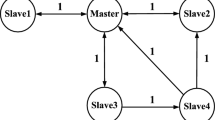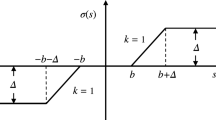Abstract
This paper studies the synchronized output regulation (SOR) problem of networked dynamic systems with switching topology that is uniformly connected and leader-rooted. In these networked systems, the tracked signal or the rejected disturbance is generated by the same exosystem, and however, the state of the exosystem is only available for leader nodes. First, a synchronization observer of the exosystem is proposed in this paper to overcome the difficulty caused by the unavailable state of the exosystem for follower nodes with directed switching information flow. It is shown that the observer state will synchronize to the state of the exosystem. Then, two feedback controllers based on decentralized dynamic error and state are presented to solve this SOR problem. Furthermore, the main idea in this paper will provide a promising way for realizing the multirobot systems’ tracking and formation requirement. Numerical simulation results are presented to demonstrate the effectiveness of the theoretical results.
Similar content being viewed by others
References
S. H. Strogatz, I. Stewart. Coupled oscillators and biological synchronization. Scientific American, 1993, 269(6): 102–109.
W. Ren, R. W. Beard, E. M. Atkins. Information consensus in multivehicle cooperative control. IEEE Control Systems Magazine, 2007, 27(2): 71–82.
H. Yang, L. Sheng. Pinning control of a generalized complex dynamical network model. Journal of Control Theory and Applications, 2009, 7(1): 1–8.
G. Chen, X. Wang, X. Li, et al. Some recent advances in complex networks synchronization. Recent Advances in Nonlinear Dynamics and Synchronization. Porland: Spring-Verlag, 2009: 3–16.
W. Ren, Y. Cao. Overview of recent research in distributed multiagent coordination. Communications and Control Engineering. London: Spring-Verlag, 2011: 23–41.
L. Scardovi, R. Sepulchre. Synchronization in networks of identical linear systems. Automatica, 2009, 45(11): 2557–2562.
Z. Yang, Z. Liu, Z. Chen, et al. Controlled synchronization of complex network with different kinds of nodes. Journal of Control Theory and Applications, 2008, 6(1): 11–15.
H. Kim, H. Shim, J. H. Seo. Output consensus of heterogeneous uncertain linear multi-agent systems. IEEE Transactions on Automatic Control, 2011, 56(1): 200–206.
L. Ballard, Y. Cao, W. Ren. Distributed discrete-time coupled harmonic oscillators with application to synchronised motion coordination. IET Control Theory and Applications, 2010, 4(5): 806–816.
W. Ren, R. W. Beard, T. McLain. Coordination variables and consensus building in multiple vehicle systems. Cooperative Control. Berlin: Springer-Verlag, 2005: 171–188.
A. Jadbabaie, J. Lin, A. S. Morse. Coordination of groups of mobile autonomous agents using nearest neighbor rules. IEEE Transactions on Automatic Control, 2003, 48(6): 988–1001.
J. Xiang, W. Wei, Y. Li. Synchronized output regulation of linear networked systems. IEEE Transactions on Automatic Control, 2009, 54(6): 1336–1341.
M. Dorigo, D. Floreano, L. M. Gambardella, et al. Swarmanoid: a novel concept for the study of heterogeneous robotic swarms. IEEE Robotics & Automation Magzine: http://www.idsia.ch/~gianni/Papers/Swarmanoid-techrep.pdf.
X. Wang, Y. Hong, J. Huang, et al. A distributed control approach to robust output regulation of networked linear systems. IEEE Transactions on Automatic Control, 2010, 55(12): 2891–2895.
Y. Hong, X. Wang, Z. Jiang. Multi-agent coordination with general linear models: A distributed output regulation approach. The 8th IEEE International Conference on Control and Automation. Xiamen: IEEE, 2010: 137–142.
P. Wieland, F. Allgöwer. On consensus among identical linear systems using input-decoupled functional observers. Proceedings of American Control Conference. Baltimore: IEEE, 2010: 1641–1646.
J. Huang. Nonlinear Output Regulation: Theory and Applications. Philadelphia: SIAM Society for Industrial Mathematics, 2004.
J. Huang. Remarks on “synchronized output regulation of linear networked systems”. IEEE Transactions on Automatic Control, 2011, 56(3): 630–631.
C. Godsil, G. Royle. Algebraic Graph Theory. New York: Springer-Verlag, 2001.
L. Moreau. Stability of continuous-time distributed consensus algorithms. Proceedings of the 43rd IEEE Conference on Decision and Control. Atlantis: IEEE, 2004: 3998–4003.
W. Lan, J. Huang. Semiglobal stabilization and output regulation of singular linear systems with input saturation. IEEE Transactions on Automatic Control, 2003, 48(7): 1274–1280.
X. Wang, W. Ni, X. S. Wang. Leader-following formation of switching multirobot systems via internal model. IEEE Transactions on Systems on Systems, Man, and Cybernetics - Part B: Cybernetics, 2012, 42(3): 817–826.
Author information
Authors and Affiliations
Corresponding author
Additional information
This work was supported by the National Natural Science Foundation of China (No. 61104149), and the Zhejiang Provincial Natural Science Found (No. Y1090339).
Teng JIANG was born in 1987. He received his B.S. degree in Automation, from the Wuhan University of Technology,Wuhan, China, in 2009. Currently, he is a M.S. degree candidate in Control Science and Engineering at Zhejiang University. His research interests include analysis and control of synchronization of complex dynamical networks.
Yanjun LI was born in 1973. She received her B.S. and M.S. degrees from Wuhan University of Science and Technology, Wuhan, China, in 1996 and 1999, respectively. She obtained her Ph.D. degree in Control Science and Engineering, from Zhejiang University, Hangzhou, China, in 2001. Her research interests include complex networks, hybrid and nonlinear systems, system modeling and identification, system optimization and computational intelligence.
Rights and permissions
About this article
Cite this article
Jiang, T., Li, Y. Synchronized output regulation of switching networks based on synchronization observer. J. Control Theory Appl. 11, 288–293 (2013). https://doi.org/10.1007/s11768-013-1200-5
Received:
Revised:
Published:
Issue Date:
DOI: https://doi.org/10.1007/s11768-013-1200-5




